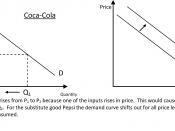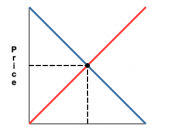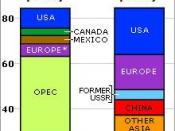Demand- a schedule or a graph showing the relationship between the price of a product and the amount consumers are willing and able to buy, ceteris paribus
Law of Demand- says there is a negative inverse relationship between the price and quantity demanded, people will be willing and able to buy more if the product gets cheaper. As price falls, quantity demanded rises, and as price rises, quantity demanded falls
Demand Schedule- shows the relationship between price and quantity demanded, holding all other factors constant à allows us to investigate the independent effect that price changes have on quantity demanded without worrying about the influence the other factors are having.
Supply- a schedule or graph showing the relationship between the price of a product and the amount producers are willing and able to supply, ceteris paribus. The schedule does not necessarily show what producers actually sell at each price. There generally is a positive relationship between price and quantity supplied, reflecting higher costs associated with greater production.
Market Equilibrium- the intersection of the demand and supply curves, indicate equilibrium price and quantity in the market à means stable
à if quantity supplied is greater than quantity demanded their will be a surplus, which will force producers to lower prices, which will reduce the quantity supplied while increasing quantity demanded until surplus disappears.
à if quantity supplied is less than quantity demanded there will be a shortage which will force producers to raise prices, which will cause quantity supplied to increase while decreasing quantity demanded until the shortage disappears.
Factors affecting consumer demand
1. Consumers Tastes- makes products more desirable, demand increases and graph shifts rightward, demand decreases will shift curve leftward
2. Consumers Income- rise in income causes increase in demand, demand for products declines as their incomes fall
3. Prices of other goods
4. Prices of related goods
5. Number of consumers in the market- decrease in buyers decreases demand
Demand Curve Shifts
1. events that increase the willingness and ability of consumers to buy will increase demand, causing and rightward/outward/upward shift
2. Events that decrease the willingness and ability of consumers to buy will decrease demand, causing a shift leftward/inward/downward shift
3. A movement from one point to another along an existing demand curve represents a change in quantity demanded, results from a change in the price of the product.
Normal Good or Service- A good or service that consumers want to buy more of when their income rises
Inferior Good or Service- A good or service that consumers want to buy less of when their income rises
Substitute Good or Service- A good or service that can be used in place of another good or service
Complement Good or Service- A good or service whose use increases the enjoyment a consumer gets from another good or service (utility), Ex. Butter, it makes bread taste better.
Determinants of Supply
1. Costs of resources
2. Changes in technology
3. Number of sellers in the market
4. Prices of other goods
5. Taxes and subsidies
6. Price expectations
A. Rightward/outward/downward shift in an increase in supply, increases the willingness and ability of firms to supply output, lowering the cost of producing any level of output increases supply.
B. Leftward/inward/upward shift is a decrease in supply, decreases the willingness and ability of firms to supply output, raising the cost of producing output decreases supply
Price Ceiling- a government mandated level above which a price cannot go. Lowest level on the graph that cannot be passed. Shortage of products lead to black markets in the product. Equilibrium prices are too high
Price floors- government mandated level below which a price cannot go. Equilibrium prices promise to be too low, this creates surplus
Market- an institution or mechanism that brings together buyers (demanders) and sellers (suppliers) of particular goods, services or resources. Price is discovered through the interacting decisions of buyers and sellers. Individual self interest rules.
Consumer Sovereignty- consumers determine what is produced in the economy, In a market economy, business must cater to the whims of consumer tastes or else go out of business.
Invisible Hand- Competition, the primary mechanism of control in the market economy, promotes a unity of self interest and social interest; as though directed by an invisible hand, competition harnesses he self interest motives of business and resource suppliers to further the social interest.
Competition- there must be vigorous competition in every market. Monopolistic elements will reduce output, raise prices and allow inefficiency in particular markets.
Firms- Business firms buy or rent resource, save and invest in capital equipment and produce goods and services.
Income- the goods, services, or money that wealth provides. The amount a person receives is measured over a particular period of time.
Diminishing marginal utility-successive units of a particular product yield less marginal utility, consumers will buy additional units only if the price of those units is progressively reduced
Income effect- states that a lower price increases the purchasing power of a buyer's money income, enabling the buyer to purchase more of the product than before.
Substitution effect- suggests that at a lower price buyers have the incentive to substitute what is now a less expensive product for a similar products that are now relatively more expensive
Change in demand-a shift of the demand curve to the right (increase in demand), or to the left (decrease)
Change in Quantity demanded- a movement from one point to another on a fixed demand schedule or curve. Cause is an increase in the price of products under consideration.
Law of Supply- as price rises the quantity of supplied rises, as price falls the quantity supplied falls. To a supplier, price represents revenue, which serves as an incentive to produce and sell a product, the higher the price the greater the incentive and the greater supplied.
Change in supply- A change in the schedule and a shift of the curve. Increase in supply, shift to the right, decrease in supply, shift to left.
Surplus- excess supply
Shortage- excess demand
Private Property- enables people and businesses to obtain, use, and dispose of property resources as the see fit. Encourages investment, innovation, exchange, maintenance of property and economic growth. Encourage owners to maintain their property so as to preserve or increase its value.
Freedom of enterprise- ensures that entrepreneurs and private businesses are free to obtain and use economic resources to produce their choice of goods and services to sell them in their chosen markets.
Freedom of Choice- enables owners to employ or dispose of their property and money as they see fit. Allows workers to enter any line of work for which they are qualified, and it ensures that consumers are free to buy the goods and services that best satisfy their wants.
Self Interest- the motivating force of all the various economic units as they express their free choices. It means that each economic unit tries to do what is best for itself. It involves maximizing some benefit and it doesn't preclude helping others à not the same as selfishness
Specialization- enables individuals to take advantage of existing differences in their abilities and skills,you are more likely to develop the skills it requires and to devise improved techniques when you devote all your time to a single task, you also avoid the loss of time incurred in shifting from one job to another.
Medium of exchange-makes trade easier, money is simply a convenient social invention to facilitate exchanges of goods and services.
Barter- swapping goods for goods. Poses problems for the economy because it requires a coincidence of wants between the buyer and the seller
Four Fundamental Questions
1. What goods and services will be produced- because businesses seek profits and avoid losses, the goods and services produced at a continuing profit will be produced and those produced at a continuing loss will not.
a. Profits and losses depend on the difference between the total revenue a firm receives from selling its products and the total costs of producing the product à economic profit = total revenue - total cost
b. Total revenue is found by multiplying the product price by the product sold
c. Total cost is found by multiplying the price of each resource used by the amount employed and summing the results.
2. How will the goods and services be produced?
3. Who will get the goods and services?
4. How will he system accommodate change?
Economic costs- the payments that must be made to secure and retain the needed amounts of those resources
Economic Profit- pure profit, an above normal profit, it is what lures other producers to a particular industry, The total revenue from the sale of a product exceeds all economic costs and the remainder goes to the entrepreneur as an added reward
Normal profit- the payment for or cost of the entrepreneurs contributions. Include wage, salary payments to labor, interest, and rental payments for capital and land, also payments to the entrepreneurs for organizing and combing the other resources to produce commodity.
Expanding Industry- as new firms, attracted to above normal profits, are formed or shift from less profitable industries. As new firms enter an industry the supply of products will increase relative to the market demand. This will lower the market price of the product, and economic profit with gradually disappear. The supply and demand conditions prevailing when economic profit = 0 will determine the amount of product produced, this is when the industry is at its equilibrium size, until further change in demand or supply changes
Declining Industry- if losses are persistent, some firms go outta business or migrate to more prosperous industries where normal or economic profits prevail.
Consumer Sovereignty- works through consumers demand, and consumer demand is crucial in determining the types and quantities if goods produced.
Dollar votes- consumers register their wants via the demand side of the product market. Increase in consumer demand = enough dollar votes are cast to provide and economic profit à industry expands, as will output of the product


